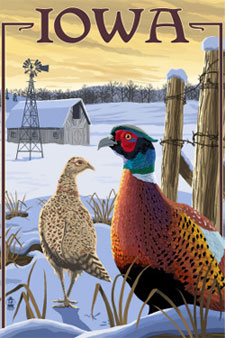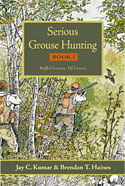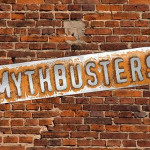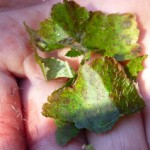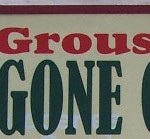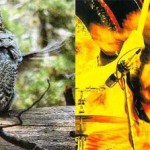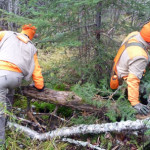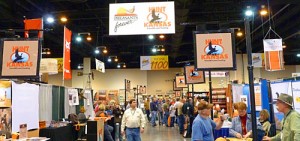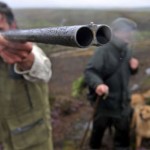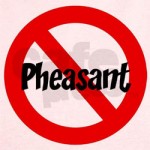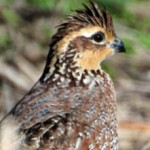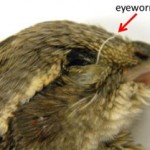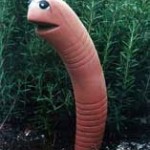Iowa Tackling Pheasant Decline
Word is the pheasant situation in Iowa is so bad that Iowa hunters are heading to South Dakota to hunt birds. But the silver lining may be not taking the birds and their habitat for granted. More below, from a couple Iowa papers.
The Issue
From the Knoxville, IA Journal Express:
> With pheasant hunting season beginning Oct. 29, more and more hunters will make the trip to South Dakota since Iowa has seen a large drop in pheasant numbers and land to hunt them on.
> “Honestly, I have personally never seen a greater drop in a game species in my lifetime than what I’ve seen with Iowa ringneck pheasants,†said Kurt Baker, director of the Wapello County Conservation Board.
> In years past, more than 1 million pheasants were harvested per year, but this year’s prediction only sits around 150,000 to 200,000. And because the bird numbers have dropped, in turn so have the number of hunters, “unless you’re a diehard,†he said.
> “Typically when April and May precipitation exceeds 8 inches, it really impacts production and we’ve seen that for the last four to five years,†he said. “As a result of spring wet conditions, very few brood[s survive].â€
> The next season that presents a problem is winter. “In southern Iowa, there have been several winters in a row in which snowfall exceeded 30 inches,†he said.
> While weather has been the major factor, Baker said the “third prong†is habitat. “Iowa lost a lot of CRP [Conservation Reserve Program] ground to agriculture as a result of high corn and soybean prices,†he said.
> According to the Iowa Department of Natural Resources, “from 1990 to 2005, Iowa lost 2,500 square miles of CRP, hay and small grain lands†and “485 square miles of CRP has gone back to row crops since 2007.â€
> Rural Iowa communities have been hit financially. “It’s had a tremendous negative impact on economic development and money coming into these small rural communities,†he said. “On opening day it used to be that people from all over the country came and you couldn’t find a rural hotel room. You can go by any rural motel now in southern Iowa and there will be barely a car there,†he said.
> Private landowners also need to step up to the plate. “Ninety-eight percent of Iowa land is privately owned,†Baker said. “Iowa landowners hold the key in terms of a future pheasant population. It would be nice if every landowner could do something in terms of habitat development.â€
> [But] larger farms and absentee landowners have made it difficult for individuals to get permission to go on private property, Baker said. “It’s becoming more and more difficult for the average person to hunt on private land, therefore those citizens that want to hunt go to the few public properties we have,†he said.
The Silver Lining
From the Mason City Globe Gazette:
> Left without a weather changing device, the Iowa DNR and other conservation groups are working to improve existing habitat and getting new habitat on the ground so when Mother Nature does relent, pheasants are in the best position for recovery.
> That work includes increasing habitat on private land, using the federal farm bill, conducting an Iowa Legislature-sponsored pheasant and quail restoration pilot project, participating in a new habitat for hunting access pilot project and developing a new pheasant plan targeting Iowa’s various climate regions.
> In 2002, the DNR conducted a pheasant and quail restoration pilot project on private land, primarily in four counties in southern Iowa — Clarke, Decatur, Lucas and Wayne. The DNR paid for habitat improvement on about 2,500 acres per year for five years.
> The study concluded in 2007 and used spring crowing counts to judge the outcome. There was an average of 6.4 roosters per stop on the managed farms versus two roosters on unmanaged farms. Quail counts found similar results — 2.3 bobwhites per stop on managed farms versus 0.2 on unmanaged farms.
> “Those numbers are not great by any means but what it shows us is that habitat will attract existing birds,†said Todd Bogenschutz, upland wildlife biologist for the Iowa Department of Natural Resources.
> Mike Nelson believes the sound of pheasant cackles will again be common across southern Iowa’s landscape. Nelson has been adding habitat on his Lucas County farm since he bought it four years ago and…it showed him that the right mix of habitat will draw and hold birds.
> Nelson installed a continuous edge, 20 acres of CRP, buffers around timber and feather edging. Each year he adds a couple of projects, including most recently planting dogwood and nine bark bushes. These efforts provide nesting and winter survival opportunity for the birds.
> Not only has he been seeing pheasants and quail on his property, he is hearing from neighbors who are seeing birds as well, which is exciting, he said. “As guys start seeing birds, they are starting to believe we can get them back,†Nelson said. “I do believe we can get there. It just takes work.â€
> That excitement is echoed by Doug Spies who jumped at the chance to buy the land he grew up hunting when it was offered for sale and then enrolled his 60 acres of rolling Woodbury County hills into the Conservation Reserve Program 12 years ago. Spies spent time and money to install high quality habitat, including adding 20 forbs, a few acres of bushes, he includes annual food plots and manages the grasslands with fire.
> The result? Unlike most of Iowa, Spies had great pheasant hunting last year and this year he even has some quail.
> The DNR has been working in partnership with Pheasants Forever’s Reload Iowa Program to ramp up efforts to help landowners establish habitat on private land. The DNR is also promoting a new three-year pilot program trading habitat improvement for hunter access.
> Iowa’s new hunting access program will establish or improve existing habitat on private property in exchange for allowing hunter access. This is the first year for the program that enrolled 10 sites in nine counties opening 1,365 acres of private land to hunters.
Category: Habitat Conservation, IA, Pheasants, Pheasants Forever, SD

